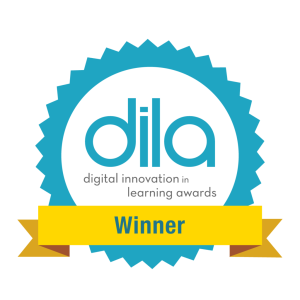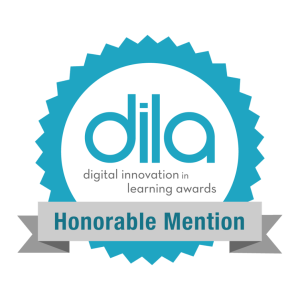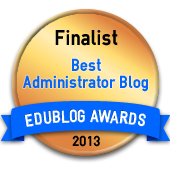Moving
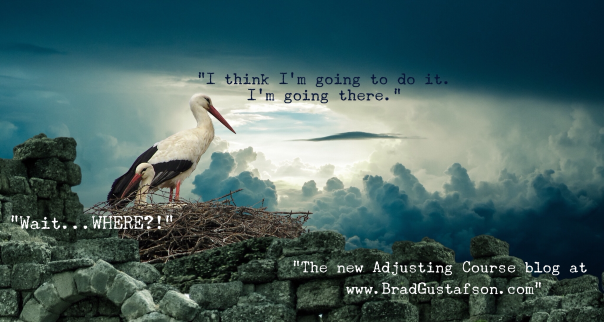
Moving is never easy…unless you’re going to a totally epic new website! That’s right!! The Adjusting Course blog has officially moved and you’re invited to come with us.
Actually…wait a second. All you need to do is “subscribe here” and we’ll deliver relevant blog posts directly to you in the comfort of your nest (or e-mail inbox).
The newest post is waiting for you right now, and subscribing takes about 7 seconds…unless you type really fast. Then it might only take 6 seconds.
We’ll see you at our new digs. You’ll be glad you joined us!
4 Surprises from Writing Renegade Leadership
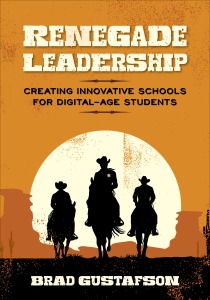
In a few short weeks my new book, Renegade Leadership, will be out. The book is about creating innovative schools for today’s students. The process of writing a book still fascinates me. The manuscript for this book was no exception, and I wanted to share a few surprises that emerged along the way.
- As I was writing Renegade Leadership, many stories from my childhood, college, and early years in education surfaced. I can be somewhat guarded at times, so I’m surprised at how natural it felt to share some of those stories. Earlier versions of the manuscript featured stories from renegade artists, engineers, athletes, and business people. However, the final manuscript includes so much more. It is injected with personal passions, renegade examples from other sectors, and the voices of dozens of highly respected educational leaders.
- I’m not sure how it happened, but when all was said and done over 30 amazing educators lent their voice and vision to the book. Their stories inspired me more than I anticipated, and I find myself reading (and rereading) the book just to take-in the incredible insights they offer.
- Feedback from preliminary reviewers surprised me. I think I underestimated the impact that sharing some of my “epic failures” might have had on readers. It seems like people really appreciated reading about the “real stuff” in education (including my many mistakes made along the way). There is a vulnerability in the book that makes me a tad bit nervous to offer it up to others.
- One of the last things I added to the book’s companion website turned out to be one of my FAVORITE memories from writing Renegade Leadership. This may sound like a shameless plug at first blush, but I assure you it is not. If you go to the companion website HERE you will find something I refer to as “Audio Outtakes” for each chapter. The Audio Outtakes include short audio clips of text from the book followed by a brief conversation between me and my 3rd grade daughter. I’ve already been told she has a future in broadcasting…but I think her secret is a genuine passion for life!
Obviously, I’m very excited to cross the “finish line” and have the book move to publication. At the same time, I hope this is just the beginning of our conversations. Our students have too much at stake for us to ignore the possibilities that meaningful change could provoke.
Renegade Leadership is available on Amazon or from Corwin Press by clicking HERE. I am very eager to hear your thoughts. Be sure to connect via the #RenLead hashtag on Twitter!
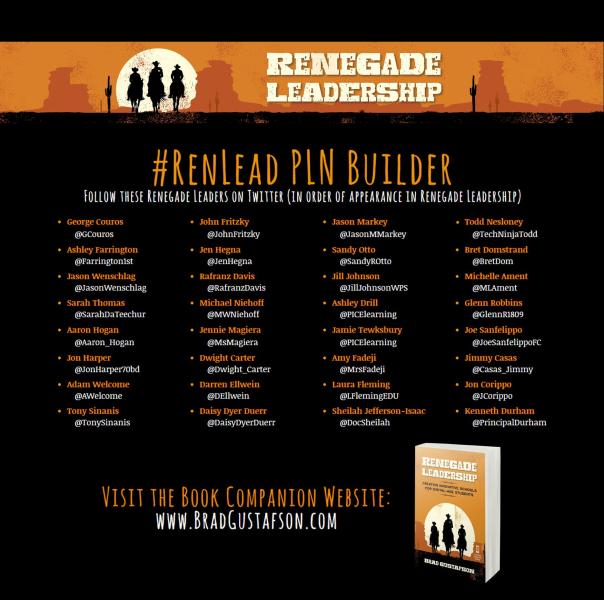
5 Ways to Connect a Class to the World
For the interactive version of this video in TouchCast click HERE.
Teaching the YouTube Generation without providing kids the opportunity to create content would be absurd. However, connecting kids to meaningful learning experiences that include other learners around the world is not always associated with traditional practice (unless you count pen pals). This TouchCast Ambassador video provides a short (3 minute) synopsis of how a class could tap into video as a transformational learning tool.
Disclosure of Material Connection: I’ve been using TouchCast for approximately three years. This year I am partnering with them as a Star Ambassador and paid consultant. TouchCast is a free app and I am not selling anything, but I want this partnership to be clear to readers.
Heads-up: The Adjusting Course blog has a new home. Check it out at www.BradGustafson.com and subscribe so you don’t miss a beat!
What’s Your One?
Have you ever returned from a conference and been asked to name a “take-away” or something you learned?
I recently had the chance to collaborate on a special podcasting project with Theresa Stager (co-host of the PrincipalPLN podcast). We were both at the NAESP national conference in Maryland and presented a session on podcasting together in the Innovation Lab. Click HERE to view the live NAESP podcast.
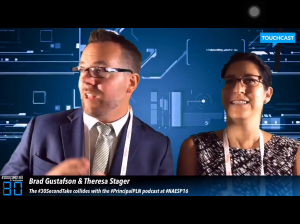
During the session and live-podcast, we asked school leaders their “one” takeaway. In addition to hearing what conference attendees were learning, we also wanted to model just how easy starting a podcast can be. (Clearly, we needed to spend a tad more time setting up the green-screen lights, but getting over the need for perfection is a big step to actually starting a podcast!)
I’ve always maintained that one of the best ways for principals to provide relevant instructional leadership is to model using relevant communication platforms like face-to-face conversation, social media, and podcasting. A podcast is also a great way to shine the light on the incredible work students and staff do on a daily basis, so there are many reasons to start.
We hope you enjoyed hearing from the inspiring (and brave) school leaders as they shared their “one” conference takeaway. We also hope that you consider trying podcasting as a school or classroom communication tool.
I’d love to hear what your “one” was from NAESP16 in the comments section below, as well as other reasons you’ve used podcasting in your classroom or school.
**Be sure to hop over to this blog’s new home at www.BradGustafson.com for more Adjusting Course goodness. In less than seven seconds you can subscribe and have the blog delivered right to your virtual doorstep.
My Pastor was Right. Again.

So a funny thing happened a few years ago. I was sitting in church and our pastor at the time, Steve Wiens, started talking about neuroplasticity. I’ve always been a big nerd at heart, so I immediately took interest. Actually, I was totally eating the science up and loving every second of it. The truth of the matter is that Steve’s message helped me overcome some gunk in my life, and it’s a message I still carry with me when reflecting on change, innovation, and education.
In a nutshell, here’s what I gleaned from Steve’s sermon. We all have habits, tendencies, or even addictions that have become hard-wired into us. Some of these habits are good (holding the door for others, showering, and saying “thank you” are a few examples). Other habits are not so good. In fact, they can be downright destructive (fill in the blank with whatever unhealthy habit or failed New Year’s resolution you have here). If you’re an advanced learner or high-flyer you’re already connecting my sermon notes to education…but try to live in the moment and bear with me one more paragraph.
Our pastor likened these tendencies to footpaths formed in the snow. (I live in Minnesota mind you, so I hope you’re envisioning a lot of snow and very deep footpaths!) The more we travel a path, the easier it becomes to travel. Conversely, forging a new path can be extremely challenging. The first few times through the snow are always the toughest. In fact, it can be so difficult to take a new path that we might choose to revert down the same old path even when we recognize it is no longer the right direction in our lives.
Now on to the neuroscience of educational change. Creating new neurons involves linking something new to existing schema. (Remember, you can’t do this without a new path.) You’ve got to walk differently, practice, and persevere. So how might we link best practice to innovation in education? How do we connect the two in a manner that is “walkable” for others? What does that path even look like?
I believe that we’ve reached a point in education where we are collectively capable of giving kids more than they are currently receiving. All kids deserve innovative schools and I’m not okay with the fact that not all kids are experiencing this. There’s more work to do!
How do we get rid of some of the educational gunk (a.k.a. past tendencies, habits, etc.) and form some new dendrites? (See what I did there with the dendrites thing?!) I propose that we start by taking the first step. And then the next. Here are a couple examples so that this is not pure hyperbole:
- We know that students deserve redesigned learning spaces that support the 21st-century skills they’ll need…so we should take the first step in making it happen within our own sphere of influence (classroom, school, district, etc.)
- We know that we cannot be the experts of everything, and that connecting with other educators regardless of time/proximity only makes sense…so we should take the first step in helping a colleague on this path. We need to get more people connected so we can better serve our students.
Thinking different requires different steps. Different doing. And it is possible! My pastor was right.
_
Yes! This blog is moving to a new home. Hop over to www.BradGustafson.com to see how the Adjusting Course blog looks “all grown up.” I’d love your feedback on the new site too.
Where Ideas Go to Die
 Image Credit: Pixabay.com
Image Credit: Pixabay.com
Good idea. Bad idea. Things are not always black and white. Even the best ideas (or intentions) can lead to bad things if the culture of a school is not conducive to innovation.
It’s easy to say that we will do what’s best for kids, but more difficult to discern what is actually best when considering the potential impact on different stakeholders. Is research-based best practice the gold standard that we should never deviate from? Or is there room for new and untested ideas in education?
I tend to believe that kids deserve both, and so it pains me to know that there have been times that I’ve been a barrier to innovation. I know that I have made decisions that stifled progress. For example, this past school year one of our teachers approached me with an idea. He wanted to have our entire school (approximately 860 students) meet outside for an all-school photograph to commemorate our 50th anniversary…and he wanted the photo to be taken from a few hundred feet in the air.
I thought the idea of an aerial shot taken from one of our school’s drones sounded cool, but my visceral response was one of hesitancy. I tried to dissuade him because I thought that getting nearly 1,000 people (students and staff) outside at the same time would be too intrusive on teachers’ busy schedules. If I’m being completely honest, I probably also wanted to avoid undue criticism from anyone who was not super excited about the idea.
My perspective was skewed towards protecting the “routine” so we could keep moving forward. After all, what is best for kids is protecting the learning environment and their routine…right?!
Fortunately, the teacher who wanted to add this neat drone video perspective was pretty passionate about the idea. I quickly realized that a school’s 50th anniversary may actually be grounds for disrupting the routine. Long story short, we all met outside and it turned out to be some of the most amazing video footage I’ve ever seen. The best part is that our students are still raving about it.
 Image Credit: Twitter via @GWtechWPS
Image Credit: Twitter via @GWtechWPS
When I stare at the picture above it’s hard for me to distinguish their faces, but I do remember their reactions. They loved it. After watching the drone video they even started to think differently about things. I think we all did. This served as a reminder that there is an opportunity cost to what we say no to. Even if it is under the guise of “what’s best for kids.”
Most people do not wake up in the morning wanting to dash another person’s dreams…oftentimes we do it unknowingly. I pray that “What’s Best for Kids” is not where ideas go to die. I pray that I am not the person who kills them.
–
**Yes! The Adjusting Course blog is moving to a new home. Hop over to www.BradGustafson.com to subscribe to my new “ad free” blog. It will literally only take six seconds…unless your internet is slow…or you type slow…
I’ll keep cross-posting here for another month or so to give everyone a chance to switch over to the new site. (I’d love your feedback on the design too.)
My Friends Don’t Know

What do dollhouses and cookbooks have to do with teaching & reaching kids? You might be surprised!
-
How will we know?
-
How will their friends know?
-
What is the world counting on us to discover about our students?
-
What’s YOUR talent or passion?
Fast-forward twenty years, and the kitchen in our house is definitely my domain. When my wife and I went to the open house for the home that we now own, I actually sat down in the kitchen for twenty minutes and pictured myself cooking and baking for our family. Culinary discovery has been such a passion of mine for so long it’s something I hope carries over to my own children, and something I need to let my friends and students know about also!
Stop-Motion Virtual Tour
This school year, several students worked on a series of creative videos with our technology teacher, Mr. Hinnenkamp. They learned different video production skills and tinkered with stop-motion, drone photography, GoPros, and more.
Their work was part of an after-school club that provided additional time/support for students to take their learning deeper. Click HERE to view one of the videos the kids created. It’s an innovative twist on the classic virtual tour. We hope you enjoy the stop-motion tour of our school.
Be sure to check out our school’s website for more virtual tours…including one of my ALL-TIME favorites….the link is to a classic tour of our Media Center filmed from the perspective of “The Mouse on the Motorcycle!” You can see from the video that the GoPro held up under some rough conditions!

Image Credit: Pixabay
We’d love to hear your ideas for future virtual tours and special effects our students could try out. Please leave a comment or share a link to work your students and staff have created.
The Power of Connection
This week we welcomed former Greenwood Elementary students back home. Several graduating Seniors walked the hallways they once traversed as K-5 students.
Music played over the P.A. system to celebrate returning Alumni. After the “walk” the Seniors took time to reconnect with former teachers and even shared some inspiring advice with our 5th graders. Seeing the power of “connection” is hard to put into words.
This short (2 minute) video captured a few of the hugs, high-fives, and connections that were made. Click HERE to view the video.
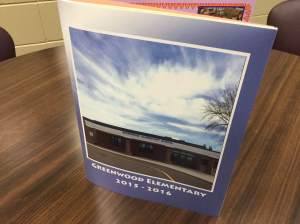
We’ll also be embedding this video into our K-5 students’ yearbooks using augmented reality (AR) technology. To view the video using AR follow these three quick steps:
- Download the Aurasma app
- Follow the “Greenwood Elementary” channel
- Point the Aurasma viewfinder at the cover of the yearbook and watch the magic begin.
In addition to the “Welcome Home” video, we will also include several other fun surprise videos throughout the yearbook that are accessible using augmented reality and the directions above. Enjoy the memories and stay connected!
“Once a Grizzly…Always a Grizzly.”
Image Credits for Video:
Thanks to Adam Hinnenkamp for the drone footage of Seniors as they arrived!
Special thanks to Greenwood Elementary and Wayzata District staff for sharing photos to the #GWgreats Twitter hashtag and shared folder in Google Drive.
Digital Time Capsule (video)

Image Credit: Pixabay.com
Greenwood Elementary School is celebrating its 50th Anniversary this year, so we are planning a birthday bash! In addition to making some more memories at a community cookout (with a DJ playing favorites from the 1960’s as well as today’s hit songs) we wanted to share some of our favorite memories.
Click HERE for our “Digital Time Capsule.” The time capsule is our attempt to honor the past while connecting our school’s rich history to students in a meaningful manner. The 11 minute video will tug at your heart strings, but it will also leave you smiling. Thank you to all the dedicated professionals, families, and volunteers who have invested so much into our students’ lives. Your legacy will always live on.
Our Digital Time Capsule video (above) features the voices of many incredible educators (past and present), but we thought you might like to see more of what our students are currently learning. Check out the four minute video below. I’m excited to see what our students will accomplish the next 50 years!



